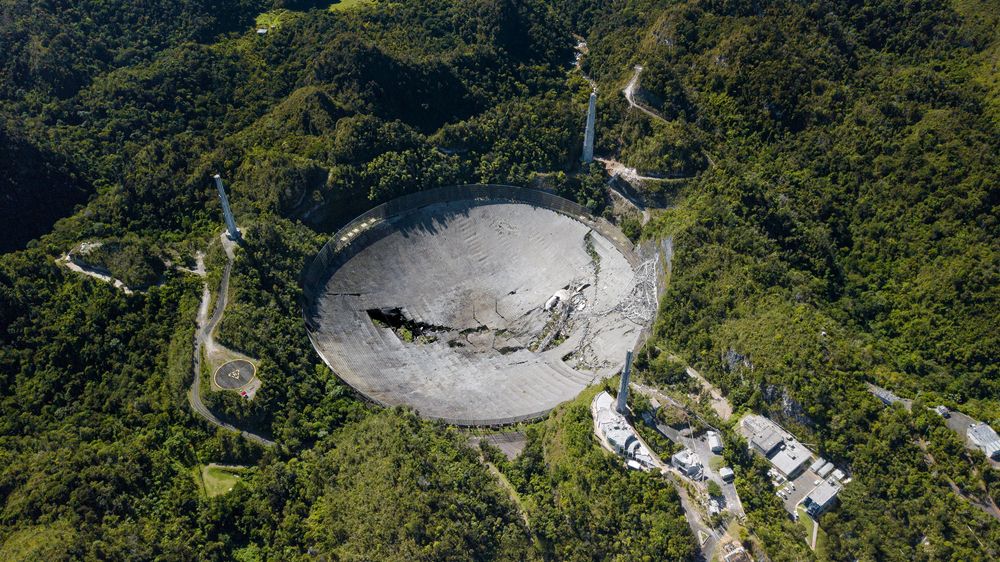The Quest For Arecibo 2.0
Posted on Categories Discover Magazine

For almost 60 years, the world’s most iconic radio telescope consisted of a 305-metre dish built into a natural sinkhole in Puerto Rico with a 900-tonne receiver suspended above. But on 1 December 2020, the receiver plummeted to the ground after its supporting cables snapped, destroying the dish.
The US National Science Foundation, which runs the facility, had long been aware of the ageing observatory’s shortcomings. Indeed, it had closed the observatory and announced plans to demolish it. But it also said that the huge cost of replacing it was too much for its already overstretched budget. There would be no new telescope at Arecibo.
That looked like the end of an international icon — the observatory having appeared in numerous films, such as Species, Contact and most famously the Goldeneye James Bond movie.
Dish Dash
But now a grass roots team of staff at Arecibo, together with telescope users, have other ideas. They say the collapse left a significant scientific void for the researchers who used to use it. To solve this, they have collaborated on a new design that will be more capable and more cost effective than anything conceived before. “We show that it surpasses all other radar and single dish facilities,” say Anish Roshi at the University of Central Florida, and colleagues, who have published their design.
One option for a future observatory at Arecibo is a single dish to replace the old 305-metre design.
But Roshi and co say a more cost-effective approach is to create a steerable structure supporting 102 smaller dishes, each one 13 meters across.
Together, these dishes will have the collecting area equivalent to a single dish 130 meters across. The team call their device the Next Generation Arecibo Telescope-130, or NGAT-130, and have already begun collaborating on its design.
One of the key challenges is understanding how the structure will deform as it moves. Large radio dishes are known to change shape as they swivel because of the force of gravity. This is relatively easy to correct provided it does not happen during an observation.
So an important goal is to work out at what rate the new structure will deform and whether this is slowly enough to allow the kind of observations astronomers want to make. To that end, Roshi and co propose creating a detailed computer model of the machine to see how it behaves. They then need to develop electronics that will compensate for any pointing or focus deviations that the deformation causes.
Another question is how the many small dishes will interact electromagnetically with each other. That will require detailed simulation too. “We plan to undertake these tasks in the coming years and encourage collaborations to these ends from those who are interested,” say the team.
Although this device will have a diameter of up to 175 meters it will be scientifically competitive with a single 300-meter dish. And it will be extraordinarily adaptable.
Multi-Tasking
One application will be to map the radio emissions from hydrogen atoms and molecules such as carbon monoxide and ammonia, throughout the galaxy and beyond. Another is to study the Sun by monitoring radio emissions from coronal mass ejections. It will also be able to study the Earth’s ionosphere and even to spot Earth-threatening asteroids.
All that makes it crucial for radio astronomers but also for planetary scientists and atmospheric scientists. Indeed, the previous Arecibo Observatory served all three groups, which is why it was so unique and useful.
But the key question is whether the National Science Foundation, or anybody else, will pay for the new observatory. “Our preliminary study shows that a NGAT of size ∼146 m, with one hundred and two 13 m diameter dishes could be developed economically,” say Roshi and co.
There will need to be some significant lobbying ahead. And if all else fails, there is always Hollywood. Perhaps it is time for Tinseltown to repay its debt to the astronomical community, while contributing to a fabulous new set for future movies.
Ref: The Next Generation Arecibo Telescope: A preliminary study : arxiv.org/abs/2305.07780